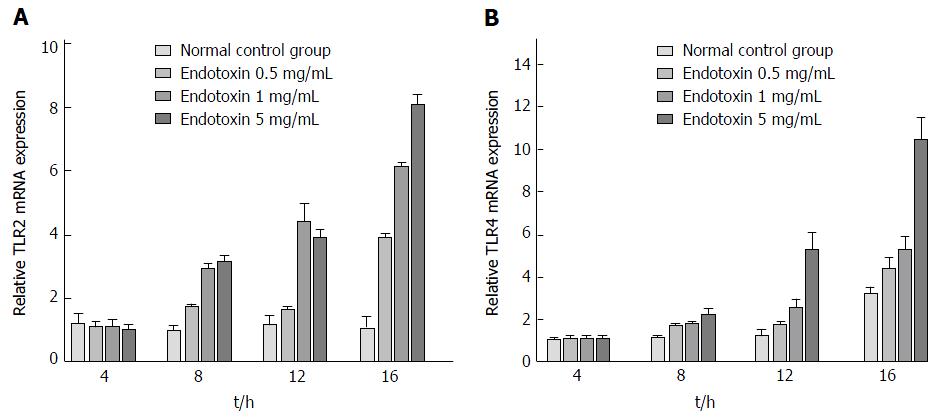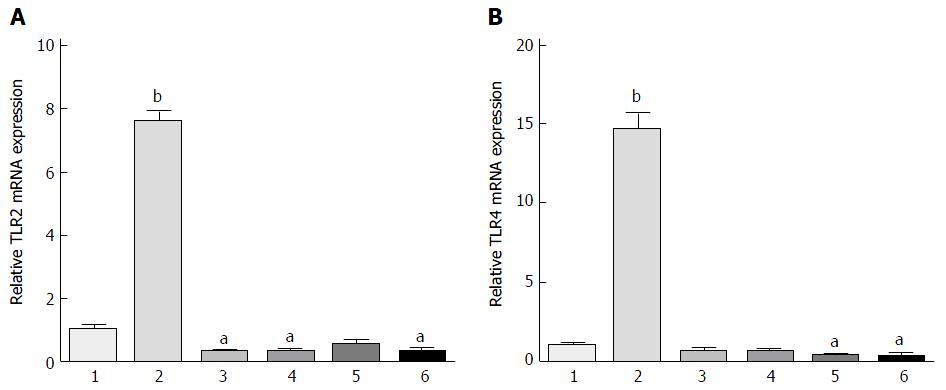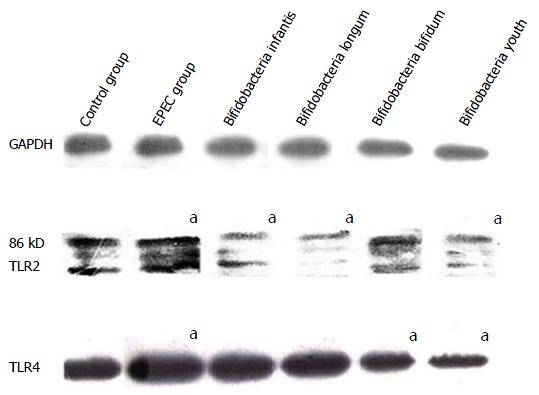Copyright
©The Author(s) 2017.
World J Gastroenterol. Jul 14, 2017; 23(26): 4744-4751
Published online Jul 14, 2017. doi: 10.3748/wjg.v23.i26.4744
Published online Jul 14, 2017. doi: 10.3748/wjg.v23.i26.4744
Figure 1 Toll-like receptor 2 and toll-like receptor 4 mRNA expression in intestinal epithelial cell-18 cells post-treatment with EPEC endotoxin at different time points.
A: TLR2 mRNA expression in the EPEC groups was significantly higher at 12 h and 16 h, compared to the control group (P < 0.05); B: TLR4 mRNA expression was highest in the EPEC group at 16 h. TLRs: Toll-like receptors.
Figure 2 Toll-like receptor 2 and toll-like receptor 4 mRNA expression in intestinal epithelial cell-18 cells after treatment with EPEC endotoxin and bifidobacteria for 16 h.
TLR2 and TLR4 mRNA expression was significantly upregulated in the EPEC group. A: TLR2 mRNA expression in B.infantis, B.longum and B.youthgroups were significantly lower than in the control groups; B: TLR4 mRNA expression in B.bifidum and B.youth groups were significantly lower than in the normal control group.1, 2, 3, 4, 5 and 6 represent normal control, EPEC, B.infantis, B.longum, B.bifidum and B. youth groups, respectively. aP < 0.05, bP < 0.001 vs the control group. TLRs: Toll-like receptors.
Figure 3 Toll-like receptor 2 and toll-like receptor 4 protein expression in intestinal epithelial cell-18 cells after treatment with EPEC endotoxin and bifidobacteria intervention for 16 h.
TLR2 and TLR4 protein expression levels in the EPEC group were significantly higher than in the control group. TLR2 protein expression levels in the B.infantis, B.longum and B. youth groups were significantly lower than in the control group. TLR4 protein expression was down-regulated in the B.bifidum and B. youth groups. aP < 0.05 vs the control group. TLR: Toll-like receptor.
Figure 4 Changes in intestinal epithelial cell-18 cell membrane resistance after treatment with EPEC endotoxin and bifidobacteria for 16 h.
The transepithelial electrical resistance in the B.infantis, B.longum, B.bifidum and B. youth groups decreased by only 19%, 18%, 23% and 23% respectively after 120 min of intervention,as compared with the control group. However, the transepithelial electrical resistance in the EPEC intervention group reduced significantly, by 67% compared to the normal control group (P < 0.05).
- Citation: Yang X, Gao XC, Liu J, Ren HY. Effect of EPEC endotoxin and bifidobacteria on intestinal barrier function through modulation of toll-like receptor 2 and toll-like receptor 4 expression in intestinal epithelial cell-18. World J Gastroenterol 2017; 23(26): 4744-4751
- URL: https://www.wjgnet.com/1007-9327/full/v23/i26/4744.htm
- DOI: https://dx.doi.org/10.3748/wjg.v23.i26.4744












